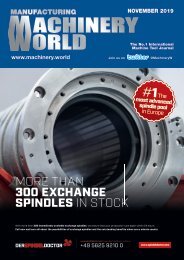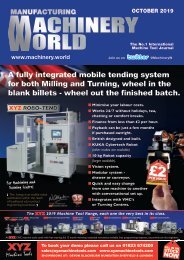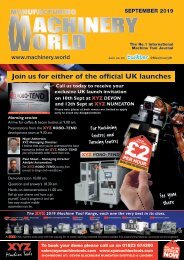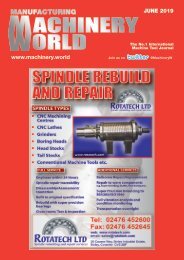Machinery World April 2017
Machinery World was launched in 1982 to serve the machinery & production engineering market. Editorially Machinery World is a news and information source that gives direct contact with the provider of innovative services and equipment. Editorial is available both online and in hard copy.
Machinery World was launched in 1982 to serve the machinery & production engineering market.
Editorially Machinery World is a news and information source that gives direct contact with the provider of innovative services and equipment. Editorial is available both online and in hard copy.
Create successful ePaper yourself
Turn your PDF publications into a flip-book with our unique Google optimized e-Paper software.
LASER, PLASMA & WATER JET CUTTING<br />
CHANGING OF THE GUARD<br />
In further evidence that fibre laser<br />
technology has taken over from CO2 when<br />
cutting sheet metal and plate, Bystronic UK<br />
has revealed that since August 2015 the<br />
company has not sold a single CO2 laser<br />
cutting machine in Britain or Ireland.<br />
Conversely, fibre laser cutters have sold well.<br />
In November and December 2016 alone,<br />
orders for 14 were taken. Two of the<br />
machines were 8kW, with a further five<br />
equipped with a 10kW fibre laser source.<br />
Among the latest takers is bicycle<br />
aftermarket component manufacturer, Hope<br />
Technology, based in Barnoldswick, which<br />
has installed a 4kW BySprint Fiber 3015.<br />
“We use relatively thin materials, such as<br />
2mm stainless steel for brake discs and up to<br />
6mm aluminium for some sprockets,”<br />
explains production manager Lindley Pate.<br />
“For thinner gauges, compared with an<br />
equivalent CO2 source, the fibre laser<br />
produces components three times faster. It<br />
has made a fantastic difference in helping us<br />
to meet growing order volumes.”<br />
The machine is equally capable of<br />
handling much thicker material. Hope often<br />
processes 12mm thick aluminium tooling<br />
plate to produce fixtures for other machines<br />
on the shop floor.<br />
A further advantage of fibre laser cutting,<br />
according to Mr Pate, is the high quality of<br />
cut using nitrogen as the cutting gas: “The asmachined<br />
edges on stainless steel appear<br />
polished, so brake discs, for example, need<br />
no edge finishing. They go straight to heat<br />
treatment.”<br />
Elsewhere, Nottingham-based Goodman<br />
Metal Works has recently taken delivery of<br />
the UK’s first Prima Power 4 x 2m capacity<br />
Laser Genius. The 6kW fibre laser cutter is<br />
capable of processing 25mm thick mild steel<br />
and 20mm stainless steel.<br />
“With a tolerance accuracy of 0.03mm, our<br />
new Laser Genius machine provides the<br />
flexibility we need,” says managing director<br />
Richard Goodman. “In addition, while the<br />
quality of our output and the speed of our<br />
production systems assists customers, it is<br />
critical that we are able to quote competitive<br />
prices. Compared with modern systems, our<br />
previous laser cutting machine was proving<br />
uneconomical in terms of its consumption of<br />
electric and gas, while its maintenance costs<br />
were continually rising. Now, the use of our<br />
Prima Laser Genius machine has considerably<br />
improved efficiencies in all of these areas.”<br />
Clearly, fibre laser profiling technology is<br />
in high demand, a fact also confirmed by<br />
Yamazaki Mazak, which announced a record<br />
year in 2016 for sales of laser machines in the<br />
UK. Mazak says the growth has been<br />
achieved across a variety of sectors, with<br />
particularly strong performance in<br />
construction and general subcontracting –<br />
the company’s 6kW Optiplex 3015 Fiber II<br />
has proved the stand-out performer.<br />
This year, Mazak is looking to introduce a<br />
number of new products, including Direct<br />
Diode Laser (DDL) technology, the Super<br />
Turbo-X 3015 Fiber and new laser<br />
automation systems. With regard to the<br />
latter, Mazak’s latest Quick Cell laser<br />
automation technology is available in three<br />
different specifications: six-pallet, 10-pallet<br />
and 14-pallet. It offers loader/unloader<br />
travelling speeds of 54m/min and an<br />
elevating speed of 8m/min, along with a<br />
sheet change time of circa 60 seconds<br />
depending on sheet size.<br />
Over at Amada, development efforts have<br />
yielded the just-released LCG-AJ flat-bed<br />
laser cutter, which can be equipped with the<br />
company’s own 2, 3, 4, 6 and 9kW oscillators.<br />
Most models incorporate an automatic<br />
nozzle changer for uninterrupted processing,<br />
and all are compatible with Amada’s Digital<br />
Support System (ADSS), which facilitates the<br />
delivery of service support and allows<br />
customers to analyse and compare machine<br />
performance. Furthermore, LCG-3015AJ<br />
machines are fully compatible with Amada’s<br />
latest part-picking system, the TK L.<br />
LVD, too, has expanded its fibre laser<br />
cutting machine portfolio with the<br />
introduction of the Phoenix FL 4020 and<br />
Phoenix FL 6020, which are designed to<br />
handle sheet dimensions of 4000 x 2000mm<br />
and 6000 x 2000mm respectively. Available<br />
in 3, 4 and 6kW versions, the latest Phoenix<br />
models are said to achieve superior cut<br />
quality through a cutting-head design that<br />
allows automatic adjustment of focus<br />
position and focus diameter, known as ‘zoom<br />
focus’. Additionally, to achieve the highest<br />
speed on every material thickness, focus<br />
position and diameter are automatically<br />
controlled and adjusted by the CNC.<br />
The increasing popularity of fibre lasers in<br />
the UK market has led to a boom in business<br />
for MSS Nitrogen’s Nitrocube Fiber nitrogen<br />
generators, which are based on a modular,<br />
plug and play design. Compressed air goes<br />
into the system and high-purity nitrogen<br />
comes out. Among the growing list of<br />
customers is ES Solutions, based in Beeston.<br />
Managing director Eric Seymour says: “We<br />
purchased the very first MSS nitrogen<br />
generator back in 2004. However, the new<br />
Nitrocube Fiber is a fraction of the size, far<br />
more efficient and saves us a significant<br />
amount of money each month. Nitrogen<br />
generation is definitely the way forward,<br />
especially for fibre lasers.”<br />
Of course, laser cutting is not the only<br />
profiling technology performing strongly at<br />
present; the demand for plasma cutters<br />
continues apace. This is evidenced by<br />
Ballymena-based Arcon Engineering, which<br />
has recently invested in a RUR3500P machine<br />
from Kerf Developments that features a<br />
Lincoln Electric Spirit 400 Amp plasma unit<br />
with Ultrasharp technology. Arcon says that<br />
the machine is powerful enough to cut<br />
through material far beyond the scope of a<br />
laser. In addition, the system incorporates a<br />
water reservoir that keeps the cutting torches<br />
cool and extends the life of consumables.<br />
Also featured is technology that is said to use<br />
up to 78% less plasma gas than competitor<br />
machines.<br />
Elsewhere on the plasma front,<br />
Hypertherm has just announced its most<br />
significant advance in mechanised plasma<br />
cutting ever, with the introduction of an<br />
entirely new class of plasma called X-<br />
Definition. This new plasma is available for<br />
the first time in a 300 Amp system called the<br />
XPR300.<br />
Finally, from a waterjet perspective, Flow<br />
has recently released Compass, a contourfollowing<br />
and collision-sensing solution.<br />
Compass automatically makes cutting-head<br />
height adjustments in real time to allow<br />
precision cutting, even if the raw material is<br />
not truly flat; the cutting head always<br />
maintains the correct stand-off height from<br />
the material.<br />
It seems whatever the profiling<br />
requirement, there is today a host of fast,<br />
precise and reliable technologies able to help<br />
profiling and fabrication shops achieve<br />
genuine competitive gain.<br />
20 <strong>Machinery</strong> <strong>World</strong>, <strong>April</strong> <strong>2017</strong>

















